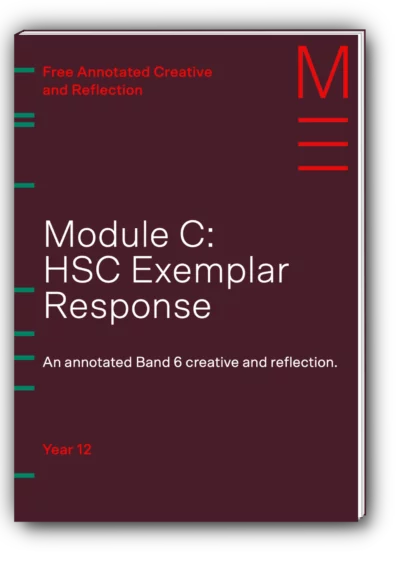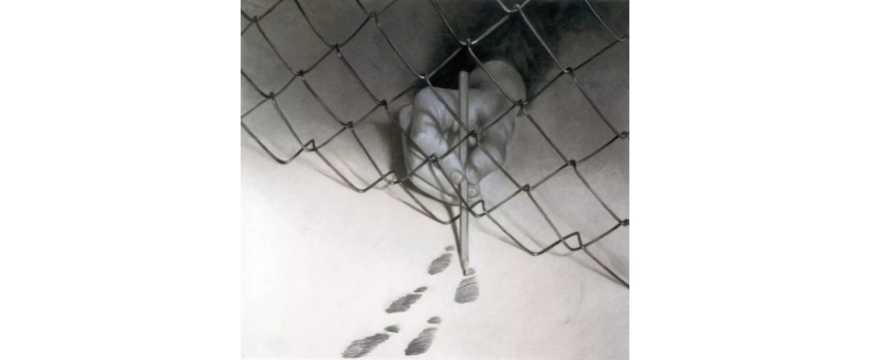Welcome to Matrix Education
To ensure we are showing you the most relevant content, please select your location below.
Select a year to see courses
Learn online or on-campus during the term or school holidays
Learn online or on-campus during the term or school holidays
Learn online or on-campus during the term or school holidays
Learn online or on-campus during the term or school holidays
Learn online or on-campus during the term or school holidays
Learn online or on-campus during the term or school holidays
Learn online or on-campus during the term or school holidays
Get HSC Trial exam ready in just a week
Get HSC exam ready in just a week
Select a year to see available courses
Science guides to help you get ahead
Science guides to help you get ahead
In this article, we'll be sharing with you an exemplary Module C creative for the 2021 HSC English Advanced exam, so you can see what you need to produce to attain a Band 6 result.

Join 75,893 students who already have a head start.
"*" indicates required fields
Related courses

Join 8000+ students each term who already have a head start on their school academic journey.
Wondering what it takes to achieve Band 6 for a Module C creative? Well, look no further!
We’ll break down the process of how to incorporate the stimulus throughout your piece to craft a Band 6 Module C creative that effectively addresses the marking criteria.
If you want to find out what makes this an excellent Band 6 Module C creative, download our annotated version of this creative AND reflection. We’ve included detailed comments about how this piece has effectively incorporated the stimulus as a central metaphor.
See a high-scoring Module C Creative response to improve your own writing! Fill out your details below to get this resource emailed to you. "*" indicates required fields
Download your HSC exemplar creative response to Module C

Download your HSC exemplar creative response to Module C
The Module C section in HSC English Adv Paper 2 often varies from year to year. The exam may involve writing both a creative and reflection, or sometimes only a creative piece (worth twenty marks).
Sometimes, you may be required to write a particular text form, such as an imaginative piece, or you may have the option to choose to write an imaginative, discursive, or persuasive.
That’s why it is so important to read the question properly!
In the past two years, students were provided an extract for the Module C section. However, the stimulus for the 2021 Paper 2 was actually an image.
Here is the stimulus from the HSC 2021 English Adv exam.

(a) Use the image provided to craft a central metaphor in a piece of imaginative, discursive, or persuasive writing (10 marks)
(b) Evaluate how your study of figurative language in The Craft of Writing influenced the creative decisions you have made in Part A (10 marks)
In your response, make reference to one or more of your prescribed texts.
Before we begin, let’s discuss what a central metaphor is, and how it can help shape your story.
A central metaphor is essentially a figurative device that is often used to represent a complex idea by drawing parallels between different concepts. A central metaphor should run throughout your whole story, and add a sense of multi-dimensionality and layered complexity into your story.
Why is this important?
Well, having a central metaphor can serve as a driving force in your story to illuminate key ideas, and help readers recognise the depth and meaning behind your work.
Let’s take a look at the stimulus above.
The first thing you see is the steel, caged fence. But what does this mean?
This could represent a barrier – perhaps some kind of restriction, oppression, or a barrier to freedom.
Now, you see a hand gripping onto a pencil. It is trying to extend beyond the fence – trying to escape. Maybe, the action of reaching out past the fence signifies rebellion, hope or a desire for change.
You look down…pencil footprints are sketched onto the surface. And, these footprints all follow the same path.
Perhaps, something about repetition, unity, or conformity.
Now that you have all these different ideas running through your mind, piece them together. And start thinking of what key ideas you could extract to create your central metaphor.
This definitely isn’t the only possible interpretation of the stimulus. But simply an option to help kickstart your own imagination. So, when provided with a stimulus, consider the figurative meaning behind it, and think creatively.
When approaching a visual stimulus, carefully analyse the image, draw out key objects or symbols, then add some context and symbolic significance. Making sure you effectively address the stimulus will help produce a more meaningful and engaging response.
After you’ve interpreted the stimulus, highlight any key symbols or features that can be translated figuratively. Then, craft your story around that particular feature or idea.
For example, the metal fence was one of the most prominent features in the stimulus above. Now, think about what you can do with a ‘fence’ (metaphorically).
Perhaps, the character feels a sense of entrapment in their world and the fence represents their barrier to freedom.
So, incorporate the idea of the character trying to surpass that barrier, and build your story around it.
How does your character interact with this ‘central metaphor’? What does your character learn from it? Is there a clear sense of development from beginning to end that has been shaped by it?
Just remember that the stimulus requires you to craft a ‘central metaphor’ – which means that you need to constantly reference it throughout your work. This is essential for scoring a Band 6 Module C response.
Now, let’s take a look at this Band 6 Module C creative that effectively addresses the stimulus and incorporates a meaningful central metaphor.
Note that this response has been written under exam conditions (40-minutes, including both Part A and B).
A Glimpse
Louise brushed the feather duster across her husband’s bookshelf. She noticed a delicate, purple butterfly painted on the spine of a book. Its wings were covered in dust. She pulled the novel out.
‘Pride and Prejudice’.
Louise smiled. Her father had always read her that novel as a child. Too bad she wasn’t allowed to read it anymore.
Suddenly, an uproar filled the usually quiet road.
Louise jumped, quickly placing the book back on its shelf. Pulling aside the embellished curtains, she peered outside. Women were marching down the street. Women without their corsets. Women holding up their bold signs.
They began climbing over the metal fences, shouting aloud words written on their signs. Their footprints imprinted onto the dirt.
Pitter patter. Pitter patter.
‘EDUCATION FOR THE WHOLE NATION!’
‘WE WILL COOK IF MEN LET US READ BOOKS’
‘FREEDOM STARTS WITH FREEDOM FROM YOUR HUSBAND.’
But the moment was cut short as their roars faded into the distance.
What was that?
Louise gazed as the crowd faded away. She wondered why those women felt they needed freedom. Were their husbands hitting them? Were they forbidding them from leaving the house?
Her husband, Andrew, would never do anything like that. He gave her an allowance, as long as she cleaned and cooked. He let her visit the library – to browse, not read. Louise didn’t need to break down any fences. She was already free.
Louise pulled back the curtains and continued sweeping the hardwood floor. She glanced at the silver stripes running down the brown wallpaper. It reminded her of the women marching down the dirt-covered roads, their bodies hurtling as they tried to climb over the metal fence.
Louise continued dusting the windowsill, however her thoughts drifted back to the words on the sign.
FREEDOM. FROM. YOUR. HUSBAND.
She wondered what that had meant.
A knock pulled Louise from her thoughts. She heard loud footsteps echo down the doorway, as she ran out to greet Andrew.
“Honey, dinner’s ready. I’ve baked your favourite pie.”
“Thanks Louise. Perhaps later, I’ve already eaten.”
Andrew went off to lounge on his armchair, while Louise continued to dust the windowsills. He sounded tired. He must be. Louise couldn’t imagine having to work all day. As Louise brushed the duster across the benches, Andrew began comfortably complaining about the pitfalls of his ‘dead-end’ career.
“I can do more than photocopy and hole punch papers.”
Louise continued nodding and dusting.
“I need to follow my dreams, you understand right? I’ve always wanted to become a journalist.”
Louise noticed there was still a speck of dust clinging onto the window. She thought she had already brushed it off.
“What did you want to be?”
Louise’s breath hitched, and she tightened her grip on the duster. She felt as though she was in a wire caged fence. Her heart began thumping as she looked for a way out of a response.
Her mother came to mind first. The woman who encouraged her to dress neatly, and cook exquisite dishes. ‘Pride and Prejudice’ came to mind second, or at least the few lines that her father had read to her.
“A woman must have a thorough knowledge of music, singing, drawing…all this she must possess.”
Louise didn’t mind drawing or playing the piano, although she would have preferred writing with a pencil, or perhaps, even read. But it had never been a question of what she wanted. It was always about staying tamely behind that metal fence, to be a good woman, and more importantly, a good wife.
“A wife?” she said, her voice just barely audible. Louise didn’t dare turn back to see Andrew’s face. She heard the armchair creak as though he leaned back into it.
Louise inhaled and bit her lip shut. She loved Andrew and she loved being married. So, she was already better than ‘Charlotte’. She was an ‘Elizabeth’. And she was happy being so.
But perhaps, there was more to life than what Elizabeth Bennett believed?
***
Louise closed her eyes again, but her mind kept flickering back to the women marching down the streets, with their footprints traced across the dirt roads and bodies trying to climb over the metal-wired fence.
Glancing at Andrew who had already dozed off, Louise tiptoed into his study.
As she searched for a glimpse of purple from the blur of brown, Louise reached for the book and brushed off the dust.
‘Pride and Prejudice’ by Jane Austen.
Now, she understood why those women were marching.
Perhaps, Louise had always been satisfied with being an ‘Elizabeth’ because the role had always been laid out for her. Perhaps, they were marching to become someone more than just an ‘Elizabeth’, someone like ‘Jane Austen’, a writer who had set the path for all other women to follow beyond the caged metal fence.
Louise took a deep breath and opened the book.
She began sounding out words printed on the page.
“‘It is a truth universally acknowledged, that a single man in possession of a good fortune, must be in want of a wife.”
But what if women wanted to be more than wives?
Start HSC English confidently
Expert teachers, detailed feedback, one-to-one help! Learn from home with Matrix+ Online English courses.
Written by Matrix Education
Matrix is Sydney's No.1 High School Tuition provider. Come read our blog regularly for study hacks, subject breakdowns, and all the other academic insights you need.© Matrix Education and www.matrix.edu.au, 2025. Unauthorised use and/or duplication of this material without express and written permission from this site’s author and/or owner is strictly prohibited. Excerpts and links may be used, provided that full and clear credit is given to Matrix Education and www.matrix.edu.au with appropriate and specific direction to the original content.